Manaslu Trek takes you deep into the Manaslu Region, one of the most pristine and less touristy Himalayan trekking regions in Nepal. The Manaslu trail winds around the tropical and lush Budi Gandaki River Valley and climbs up to the base of an eight-thousander named Manaslu, the eighth-highest mountain in the world. A traverse of Larkya La, a 5106-meter high mountain pass, adds thrill to this amazing walking adventure.
The Manaslu Trek offers an authentic Himalayan trekking experience with incredible scenery and mountain culture. Since the region lies in a restricted zone, tourist traffic is quite low, and the villages have pretty much retained their authentic ambiance. For this reason, Manaslu Trek is best suited for those who want to experience the real Nepalese mountain life and landscape devoid of commercialization.
There are also interesting side trips en route which take you to places that have been opened to outsiders as recently as the beginning of this century. The hidden Tsum Valley, which lies in the Manaslu Region, was opened for tourism only in the year 2008. Prior to that, the valley remained cut off from the outside world.
In this remote valley of Tsum, centuries-old traditions and customs are still being followed. Shyagya, or the nature-culture conservation practiced by the people of Tsum might teach the modern world a thing or two about environment conservation and sustainability.
Why Choose Manaslu Trek? Discover the Top 16 Best Reasons:-
Authentic Himalayan Trekking Experience
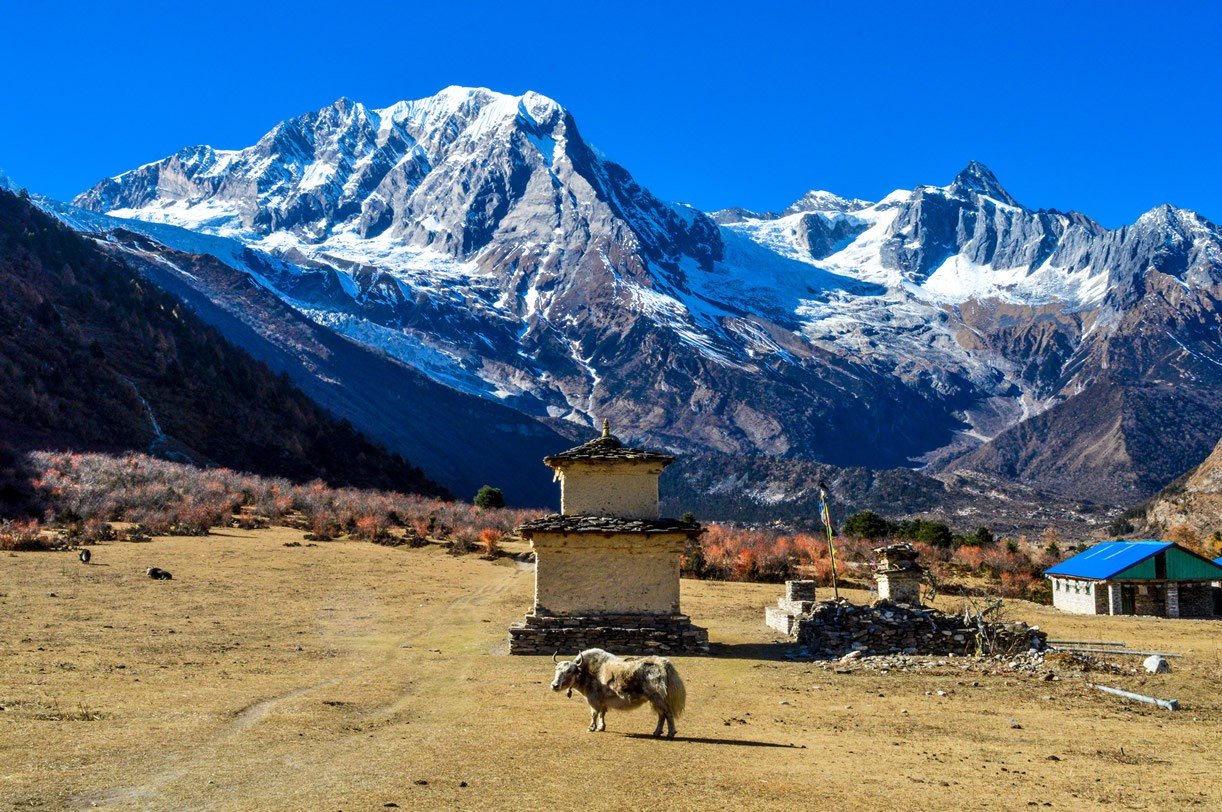
One thing Manaslu has to offer that the popular treks in Nepal have lost over the years is the authentic culture. Here you will find villagers who actually make their living from farming and cattle rearing and not as tourism entrepreneurs (as in the Everest and the Annapurna regions). The villagers do the same work their forefathers used to do. Here you will discover what village life was like in the mountainous trekking regions of Nepal before the boom of commercial trekking took over and transformed the lifestyle of the people.
Less Touristy and Less Commercialized
Since the Manaslu Region is a restricted zone, one has a pay a permit to enter the region. This makes the trek much pricier than other treks in Nepal – a reason that makes backpacking tourists stay away from the trail. Only a few groups who are really interested in discovering the amazing Manaslu area make it to the trail. And their numbers are very few.
The restricted flow of tourists has meant less disturbance and changes in the lifestyle of the locals. Unlike in the busy routes of Annapurna and Everest, you won't find many locals involved in the tourism business. While some may have opened lodges to cater to the tourists, most of them are still involved in farming and cattle rearing.
Pristine Nature
From the beginning to the end of your trek, you will be walking in a virgin and pristine trail. The trek starts from the humongous tropical forests of the Budhi Gandaki River Valley and goes up to the cold arctic zone of the Manaslu Base Camp and Larkya La. With few villages in between, the landscape is undisturbed and pristine. One can encounter glaciers, waterfalls, and streams en route, which flow down and meet the roaring Budhi Gandaki.
Suspension bridges connect deep gorges with thundering rivers flowing below. Trails are cut in rocky cliffs with exposed sides, which offer majestic views of the mountains and valleys. You will be walking through forests filled with oak, bamboo, pine, juniper, and birch trees. Much of the trail falls under the Manaslu Conservation Area, a protected zone.
Diverse Landscape and Culture
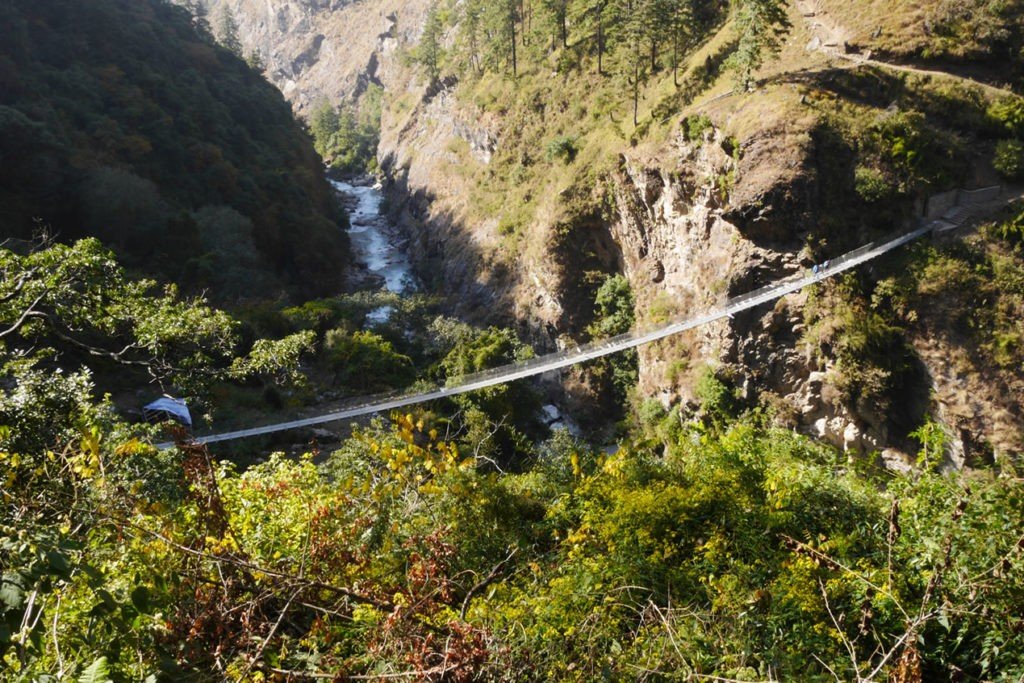
While trekking in the Manaslu Region, you will come across diverse terrain and culture. You will start your trek either from Soti Khola or Macha Kola, which lies at an elevation below 2500 meters, and climb up to an altitude above 5000 meters. From the lush and humid jungles of the Budi Gandaki valley, you will reach the frozen, snow-covered slopes of the Larkya La. You will be crossing forests with a thick cover of trees and abundant greenery and climbing snow-blanketed hills with not a single tree in sight.
The trail takes you across villages of different ethnic groups that follow Tibetan Buddhism and Hinduism. In the lower Budhi Gandaki Valley, you will find Hindu settlements of Gurung, Chettri, and Brahmin communities surrounded by terraced rice fields and banana plantations.
As you head higher, you will come across villages that have deep links with Tibet. Here people follow Tibetan Buddhism and Bon (an animistic religion that is more ancient than Buddhism). The language, daily lifestyle, and customs are similar to those in the Tibetan Highlands. In fact, people in this remote corner of Nepal seem to have preserved the Tibetan traditions much better than the actual Tibetans in the Tibetan Highlands.
Tibet has seen some major development and urbanization under the Chinese government. In the last couple of years, the rural belt, including the Tibetan villages, has also been vastly modernized, leading to the erosion of age-old customs, traditions, and lifestyles. In this corner of Nepal, it is possible to experience the authentic Tibetan Buddhist culture and lifestyle.
Safer than most high-altitude treks
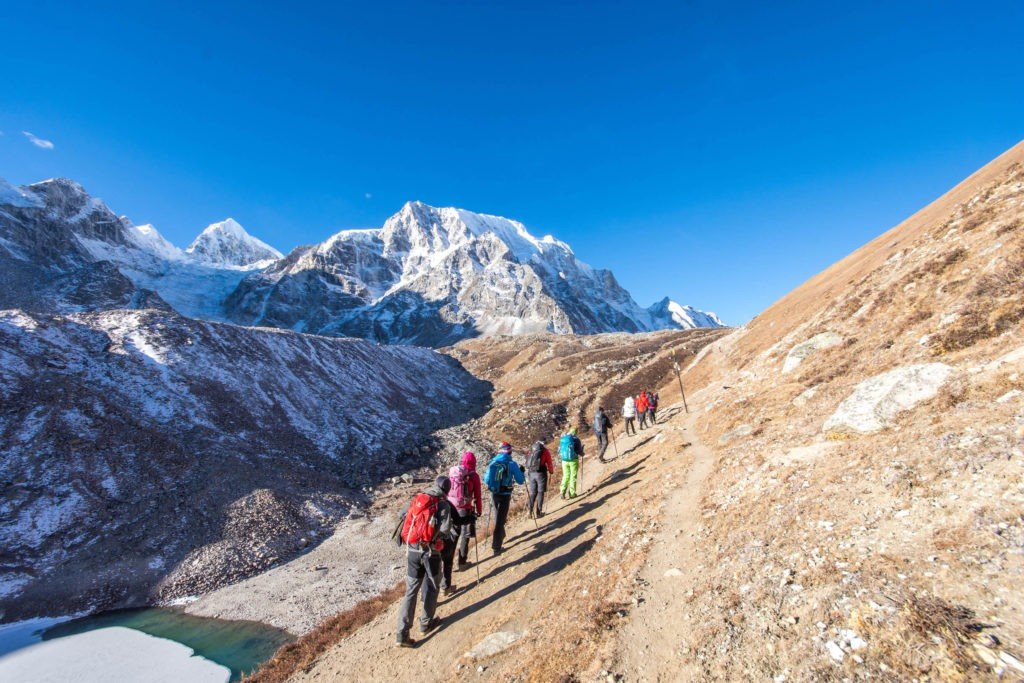
It is mandatory to trek with a guide in the Manaslu Region. Since this is a restricted zone, solo or independent trekking is not allowed. Having a guide with you automatically makes this trek safer than most treks in the Nepal Himalayas. With a guide, navigating the route won't be a problem as he will know which trail to take and how to get from point A to point B safely and swiftly.
Most of the Manaslu Region is a wild country with very few villages in between. Sometimes you will have to walk for six to eight hours to reach the next village. While the trail is well-marked and walkable, having a guide with you in the wilderness will keep you safe. He will also handle all the logistics, which will make your trek stress free.
However, it's important to take care of your personal health while trekking. Hiking in high altitude is always risky, and you should take appropriate precautions to save yourself from altitude sickness.
View of an Eight-thousander
The Manaslu Trek takes you close to Mount Manaslu. Rising to a height of 8,163 meters, Manaslu is one of the world's fourteen eight-thousanders and the eighth-highest mountain in the world. A brisk hike from the ancient village of Samagaon takes you close to the base camp of Manaslu and lets you enjoy the magnetic beauty of its snow-draped summit.
Known as the 'Spirit Mountain,' locals worship this mountain and regard it as their guardian deity. Killing and harming of all living beings, including animals, birds, and insects, is strictly prohibited in the settlements close to the mountain. On the way to the Mount Manaslu Base Camp, you will come across a beautiful mountain lake, Birendra Taal. The turquoise lake surrounded by snow-covered mountains looks stunning.
During peak climbing season, the base camp is covered with tented camps of mountaineering groups hoping to conquer Mount Manaslu. While the mountain is smaller than Mount Everest, climbing its summit is a lot more technical and challenging, according to seasoned climbers. Himalchuli, Naike Peak, Ganesh Himal, and Shringri Himal are some of the other mountains you can view closely from the base camp.
Cross Larkya La (5106m), a high Himalayan Mountain Pass

One of the highlights of this trek is the difficult crossing of a high mountain pass, Larkya La. Larkya Peak is one of the smaller peaks located close to Mount Manaslu, and the Larkya La Pass goes through this mountain. Crossing the Larkya La certainly hikes up the thrill factor of this trek.
The crossing is done early in the morning from Dharamshala or Samdo when it is still dark to avoid avalanches and high winds (which tend to roll in as the day progresses). While no technical climbing is required to cross the Larkya La, it is nevertheless challenging to walk over the pass. The pass is covered with snow whole year round and some sections are covered with slippery ice. The descent to Bimthang from the pass is extremely steep and icy. You need to have the right equipment and gear to make it over the pass safely.
Amazing Detours and Trip Extension

While on the Manaslu trail, you can take a side trip to Tsum Valley, which is one of the hidden gems of the Nepal Himalayas. The valley remained completely isolated as the Nepal government forbade outsiders from entering the valley to preserve its fragile ecosystem and culture. It was only in 2008 that Tsum Valley was opened to tourists. Divided into Upper Tsum and Lower Tsum, Tsum Valley is home to Buddhist monasteries and nunneries that are hundreds of years old. The 33 villages in the valley follow some interesting Buddhist customs which are unique to this valley.
You can also enjoy a hike to Manaslu Base Camp from the village of Samagaon. The hike is challenging and takes you to elevations of almost 5000 meters. Rui La, a high mountain pass at the Nepal-Tibet border, is also a great day hiking spot. The pass can be accessed from the village of Samdo. The trail to the Rui La pass is isolated, with no villages for miles on end. You will find only yaks grazing on the desolate mountainside. This is a good hike if you want to visit some rarely explored places. A stone at the top of the Rui La pass marks the border between Nepal and Tibet Autonomous Region of China.
If you want to explore more of the Nepal Himalayas, you can extend your trek from Dharapani and walk across the Annapurna Circuit. You can trek through the villages of Manang and Lower Mustang and cross another stunning mountain pass, the Thorung La Pass. Compared to the Manaslu Circuit, the Annapurna Circuit route is more developed. The circuit is regarded as one of the world's best high-altitude treks in the world.
No Risky Mountain Flight
There is road connectivity to the trailhead from Kathmandu. This means you won't have to stress about taking a risky flight on a tiny plane across the mountains to the trailhead. Taking a ride on a vehicle instead of a flight will also cut down your transportation cost. The more people in your group, the less you will have to pay individually. It takes around 7 to 8 hours' drive from Kathmandu to reach the trailhead.
No Roads and Noisy Vehicles
Unlike the busy Annapurna Circuit, there are no roads on the Manaslu trail. Much of the trail is still pristine and untouched. So you can look forward to a peaceful walk on foot trails filled only with nature sounds. As you won't have to share the trail with local buses and land cruisers, there will be no noisy vehicles revving past, no plumes of dust, and no blaring horns disturbing the peace and quiet of the mountains.
So there you go. Those are the ten points that we feel make the Manaslu Trek or Circuit unique from other treks in Nepal. However, here are some more points which we believe make the trek to Manaslu a once-in-a-lifetime experience.
Compared to other treks, the trekking experience across Manaslu is quite enriching and unique. Leaving aside the above ten points, Manaslu Trek is a must-do for the following reasons.
Buddhist Culture and Monasteries
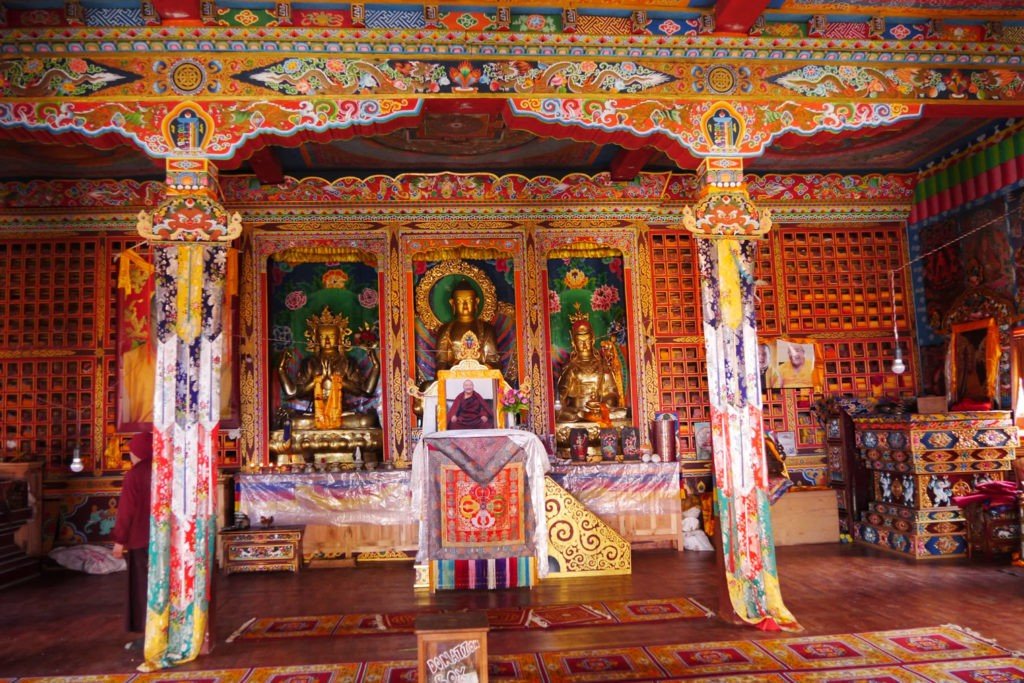
Manaslu Region is home to some of Nepal's oldest Buddhist monasteries and nunneries. There are meditation caves and shrines blessed by the Second Buddha or Padmasambhava. Milarepa, or the 'singing Buddhist saint," is said to have spent a good number of years meditating and roaming around the hills of this region. For followers of Tibetan Buddhism, the Upper Manaslu area is an important pilgrimage site. They believe these are beyuls, a hidden paradise created by Guru Rinpoche. People who live in these beyuls are said to be blessed and lucky.
Mu Gompa, Rachen Gompa, Serang Gompa, Hinang Gompa, Gompa Naktsal, Pungen Gompa, etc., are some of the ancient and important Buddhist monasteries in the region. Most of these monasteries date back several centuries and provide refuge to hundreds of monks(lamas) and nuns(anis) who devote their lives to spreading 'Dharma'. These monasteries are also home to the valuable Buddhist manuscripts and texts that were brought over from Tibet by fleeing monks who escaped the invasion of Tibet by the Chinese Red (communist) Army.
Historical Significance
The Manaslu Region used to be part of the Gorkha Kingdom, which was ruled over by the Shah Kings. Prithvi Narayan Shah, one of the greatest Shah kings, started his campaign for the unification of Nepal from the Gorkha Durbar, which lies in the Gorkha District. There was no unified Nepal or country before this military campaign. There were only small kingdoms and principalities that were at odds with each other. The present territory of Nepal is pretty much what Prithvi Narayan Shah achieved during his unification campaign.
A side trip to the hilltop Gorkha Durbar (Palace) before the start of your trek will take you to the royal seat of the Gorkha kings who ruled over Nepal for more than two centuries. Perched on top of a narrow ridge, the durbar is a fort as well as a palace. There are also Hindu shrines inside the palace complex. Though not as fancy as the palace squares of the Malla kings in Kathmandu Valley, the ornate wooden carvings inside the Gorkha Durbar are some of the most beautiful in Nepal.
Rich Biodiversity
The Manaslu Trek goes through the protected Manaslu Conservation Area, which is a rich storehouse of Himalayan flora and fauna. The conservation park covering an area of 1663 square kilometers, is home to rare animals like the Snow leopard. Himalayan Musk Deer, Blue Sheep, Himalayan Black bear, lynx, Himalayan Tahr, Himalayan Marmot, etc. The conservation area has more than a hundred species of birds and two thousand species of plants. Here you will find eleven types of forests and six climatic zones – tropical, sub-tropical, temperate, alpine, sub-alpine, and arctic. The variation in climate makes this region one of the richest biodiversity hotspots in the Himalayas.
Tsum Valley, the Hidden Paradise
Located close to Tibet and the Ganesh Himal range, life in Tsum Valley seems suspended in time. It was opened for tourism only recently, in 2008. Prior to that, even Nepalese from other parts of the country were barred from freely entering the region. Because of its proximity to Tibet and fragile cultural heritage, the government chose to protect the Tsum Valley from outside influence. But as the locals of Tsum felt their region lagging behind in development (compared to other neighboring regions like Annapurna), they requested the government to lift the ban on tourism. Their request was granted when the government allowed tourists to finally enter the Tsum Valley in 2008.
The Tsum Valley is divided into Upper Tsum and Lower Tsum. In total, there are 33 villages in the valley. The people of the Tsum Valley have their own dialect, known as Tsumba or Tsumke. A unique fact about the Tsum Valley is that all animals, birds, and insects are protected and allowed to exist without any interference from human beings.
The culture of 'Shyagya' guides the lifestyle of the people of Tsum. Shyagya, which means a tradition of non-violence in Buddhism, has been adopted by the people of Tsum. People in the valley are strictly prohibited from hunting, harvesting honey, killing animals, trading animals or their parts, burning forests, and trapping birds, animals, or insects.
If you want to visit this enchanting valley, you can book our Manaslu Circuit with Tsum Valley Trek package or the Tsum Valley Trek package.
Nubri Valley
Nubri Valley, like the Tsum Valley, is steeped in Tibetan Buddhist culture and traditions. Located close to Himalchuli, the Nubri Valley is home to some of the ancient monasteries in the region. Since Tibet lies very close to Nubri Valley, people of the valley buy foodstuff from across the border. Yak caravans are used to transport goods from Tibet to Nubri Valley. Bhi, Prok, Lho, Namrung, and Samagaon are the important villages of Nubri Valley.
Unique Festivals
While the Hindu population in the lower part of the Manaslu Region celebrates Hindu festivals that are observed in all parts of Nepal, the Buddhist settlements in the higher elevations celebrate some unique Buddhist festivals. These festivals are celebrated only in the Trans Himalayan regions inhabited by followers of Tibetan Buddhism.
Losar, or the New Year according to the Tibetan lunar calendar, is celebrated with much joy and fanfare. All the villagers wear new clothes and clean their houses during this festival. They visit the monasteries and Buddhist shrines and pray for a good year filled with good health, happiness, and prosperity.
Dhachyang, or the Horse Racing Festival, is an amazing festival where male riders vie for the top spots in horse racing and other competitions. The horse riding competition is followed by group dancing and singing.
The festival of Saka Dawa commemorates the life of Lord Gautama Buddha – his birth, enlightenment, and Parinirvana. During the festival, people make it a point to do meritorious deeds and visit monasteries.
The festival of Faning is about nourishing oneself. Delicious meals are cooked, and people treat themselves to nutritious and healthy food. Nara, a masked dance festival, is celebrated at different times of the year at different monasteries in the Tsum Valley. It is mainly observed to cleanse the spirit and the environment of bad and evil spirits.
Manaslu Trek – Route, Duration, Difficulty, and Permit
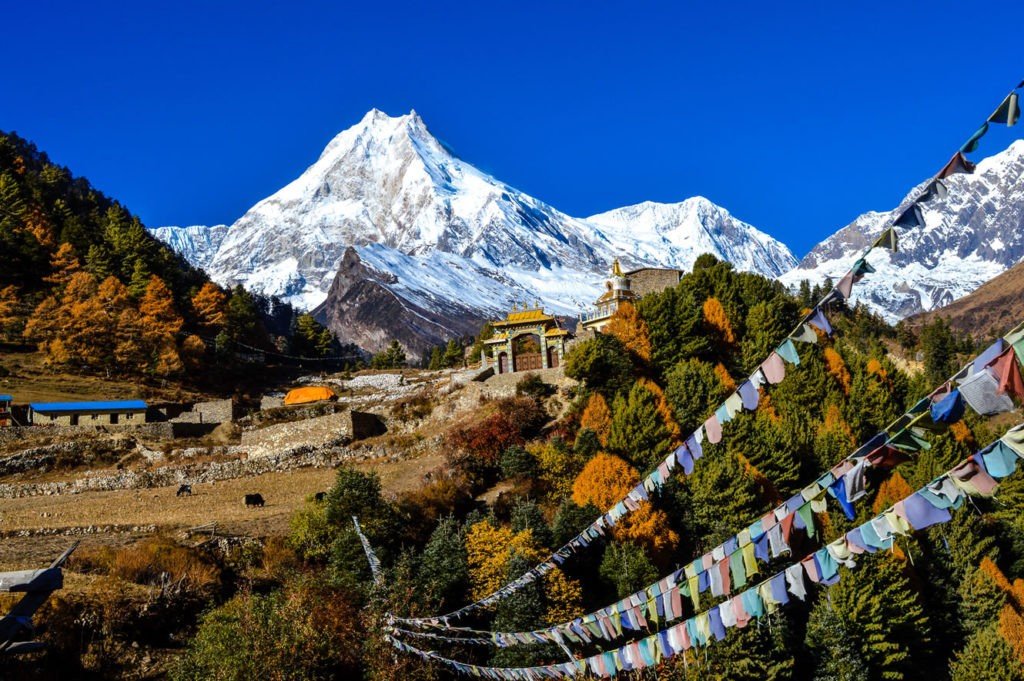
The Manaslu Trek, or Manaslu Circuit starting from Machha Khola or Soti Khola and ending in Tilije or Dharapani, takes between eleven to fourteen days to complete. You can extend your hike for a week or so by adding Tsum Valley to your itinerary. A 7-8 hours drive from Kathmandu brings you to the trailhead of the Manaslu Circuit.
You begin your trek from the lowlands of the Budhi Gandaki River Valley and walk through the tropical forests of the Manaslu Conservation Area. You ascend the Bhotia villages of Namrung, Deng, Lho, and Samagaun and take an acclimatization break to prepare your body for the tough crossing of the Larkya la, the highest point of your trek. Within a couple of days of trekking, you will walk through the tropical and temperate zones and enter the stark and barren snow line with no greenery.
After crossing the Larkya La pass, you will descend to Bimthang and make your way to the Marshyangdi River Valley and the Annapurna Region. You can end your trek either in Dharapani or Tilije, from where you can catch a vehicle bound for Besi Sahar. From Besi Sahar, you can continue your drive towards Kathmandu or Pokhara, where your trip will come to an end.
The Manaslu Trek is graded as a moderately difficult trek. There’s a lot of ups and downs and plenty of river crossings. You will have to walk on rocky cliff sides and climb steep staircases. The crossing of the Larkya La Pass is the most challenging part of your adventure. To traverse the pass, you will have to ascend a steep trail and walk on snow and ice.
The permits needed for the Manaslu Trek are – Manaslu Conservation Area Permit, Manaslu Restricted Area Permit and Annapurna Conservation Area Project Permit. These permits will be arranged by the agency.
Accommodation on the trail is not a problem as every little village on the route has a teahouse, lodge, or homestay.
What are the most commonly asked questions about the Manaslu Circuit Trek?
Here are some of the frequently asked questions about the Manaslu Circuit Trek.
How hard is the Manaslu Circuit Trek?
Ans: This is a physically demanding trek with lots of ups and downs. There are several switchbacks and river crossings which makes the trek tiresome. At some sections, the trail traverses landslide areas which makes it risky. However, no technical climbing is involved. It’s straightforward walking on well-worn foot trails. The most challenging section of the trek is the crossing of Larkya La. The mountain pass is covered in snow and has some steep inclines, which makes the crossing difficult.
Is Manaslu Circuit Trek harder than Everest Base Camp?
Ans: If you study the altitude profile of both treks, Everest Base Camp is more difficult than Manaslu Circuit. The Everest Base Camp trail takes you to elevations above 5000 meters, where the amount of oxygen in the atmosphere is only half of that at sea level. Moreover, the EBC Trek itinerary includes three nights at Lobuche and Gorak Shep, which lie at an altitude of 5000 meters. Sleeping and walking at this altitude is certainly not easy.
The highest point on the Manaslu Circuit trail is the Larkya La pass which lies at an elevation of 5106 meters. While the trek to the pass is challenging enough, the time spent at the pass is only a few minutes. After getting up on the pass you will make a quick descent to Bhimthang, which lies at an altitude of 3590 meters.
While there’s not much of an elevation gain on the Manaslu Circuit, the winding and narrow trails across uninhabited stretches make the trek physically tiring. The villages are located further apart, and it takes a long hike to reach inhabited villages on the trail. The Everest Base Camp trail has many Sherpa settlements en route where one can stop to eat and rest at intervals.
The Everest trail also has well-facilitated lodges and teahouses, which raises the comfort level of the trek. There are also luxury mountain lodges on the Everest trail, which offer high-end services to the trekkers.
Compared to the Everest Base Camp trail, the teahouse facilities on the Manaslu Circuit are more basic and rustic. The lodges are not as modern and well facilitated as on the EBC trail. However, the increased traffic in the Manaslu Region in the past few years has led the locals to upgrade the teahouse facilities.
How to train for Manaslu Trek?
Ans: It’s important to be relatively fit before you start your trek. You can start training for your trek at least six months in advance. You can take uphill hikes carrying a heavy backpack, climb stairs and jog. You can take up strength-building exercises to develop your back, core and leg muscles. Regular cardio workouts (swimming, aerobics, cycling, running, etc.) will build up your stamina and make your heart and lungs stronger. It is also important to have a balanced diet while training for your trek.
It is difficult to train for a high-altitude trek while staying at a lower elevation. However you can take precautions while trekking to avoid altitude sickness. Some of the steps you can take to mitigate the effects of high altitude on your body are keeping yourself hydrated by drinking lots of fluids, keeping yourself warm, maintaining a slow but steady pace while walking, taking deep breaths and never overexerting yourself.
Is Manaslu Circuit harder than Annapurna Circuit Trek?
Ans: The Manaslu Circuit is a bit more demanding than the Annapurna Circuit. There are a lot of ups and downs during the first few days of the Manaslu Circuit Trek which makes it physically exhausting. There are several switchbacks and river crossings which makes the Manaslu loop harder than the Annapurna Circuit. The lodges are also basic on the Manaslu side, and the villages are also situated farther apart, which makes for long days of walking each day.
Annapurna Circuit has many villages en route with comfortable lodges. The rough jeep tracks of the Annapurna Circuit are also easier to navigate than the winding and rocky trails of the Manaslu Circuit.
What is the difficulty level of Larke La Pass?
Ans: The Larkya La Pass sits at an altitude of 5106 meters and is the highest point of the Manaslu Circuit Trek. Crossing the pass is pretty challenging as one will be walking on snow and ice and climbing and descending on steep sections. It takes around 8-9 hours’ hike from Dharamshala to cross the Larya La pass. The pass is covered in snow and ice, which makes the crossing difficult. You will start your trek before daylight. The weather starts to worsen as the day progresses, so it’s wise to make an early start. It is a tiring hike up to the pass past boulder fields and icy paths. The freezing cold and low oxygen level make the trek harder. The steep descent to Bimthang is equally hard and challenging. A big reward for the challenging crossing of Larkya La is the stunning and breathtaking views of the mountains.
How long is the Manaslu Circuit Trek?
Ans: The length of the trek depends on the itinerary you choose and the pace you maintain during your trek. Usually, it takes around 11 to 14 days to complete the Manaslu Circuit Trek. However, the trek can be stretched to 18 days or more, depending on the detours and side trips. Most trekkers prefer to include a side trip to Tsum Valley, which takes an extra four to five days. From Machakhola to Dharapani, the trail is about 180 kilometers long.
How much does the Manaslu Circuit trek costs?
Ans: Every outfitter charges a different fee for the trek. The cost of the trek depends on the agency you choose, the services you are willing to pay for and how much you will spend on the trail (on hot showers, wifi, snacks, drinks, etc.). If you only pay for the guide and porter service, the agency will charge you less. But if the accommodation costs, meals, and transportation fees are also included in the total cost of your trip, then you will have to pay a hefty sum. It is better to let the outfitter take care of all the logistical details to make your trek hassle-free. Permits are also included in the total cost.
Is it worth doing the Manaslu Circuit Trek?
Ans: Yes, the Manaslu Circuit trail is definitely worth experiencing. The trail takes you off the beaten path to some of the rarely explored areas in the Himalayas. The forests along the trail are pristine and untouched. The natural beauty and the close-up view of an eight-thousand-meter peak make this trek one of the best multi-day treks in the Nepal Himalayas.
What do you need for Manaslu Circuit?
Ans: To do the Manaslu Circuit Trek, you need to have
- All the required permits
- Passport with six months validity
- A licensed guide
- Appropriate clothing and equipment, including a sleeping bag, warm clothes, crampons or microspikes
- Rainproof gear
- Sturdy shoes
- Travel Insurance which covers high-altitude rescue
- Essential Medicines (painkillers, antibiotics, Diamox, anti-diarrhea pills, etc.)
- Enough cash (local currency)
- Extra batteries and power bank
How far is Manaslu from Kathmandu?
Ans: The trailhead of the Manaslu Trek, Machha Khola, is located approximately 160 kilometers away from Kathmandu, and it takes about 7-8 hours to drive there. However, the actual mountain, Mount Manaslu, is further away and requires a 4-5 day hike from the trailhead.
Can you trek to Manaslu without a guide?
Ans: No, trekking without a guide is not allowed in the Manaslu Region. Since the region lies in a restricted area, it is mandatory to trek with a local guide.
How much is a Manaslu Trek permit?
Ans: As of July 2023 the cost of the permits are as follows :
- Manaslu Conservation Area Permit –
- For nationals of SAARC countries – NRS 1000/- per person
- For other nationals - NRS 3000/- per person
- Manaslu Restricted Area Permit -
- September to November – USD 100/- per person per week and an additional USD 15/- each extra day
- December to August – USD 75/- per person per week and USD 10/- each extra day
- Annapurna Conservation Area Project Permit:
- For SAARC nationals – NRS 1000/- per person
- For Other Nationals – NRS 3000/- per person
If you want to visit the Tsum Valley, you will have to further pay an additional fee of USD 35 for a week’s trek.
Can you do the Manaslu Circuit Trek solo?
Ans: No, solo trekking is not allowed in the Manaslu Circuit. Since Manaslu Region is a restricted zone, it is mandatory to trek with a licensed guide; There should be at least two people in a group.
How many kilometers is the Manaslu Circuit Trek?
The distance you cover depends on the starting and ending points of your trek and the side trips you will take en route. From Machha Khola to Dharapani distance is roughly 110 kilometers.
Why should you choose Manaslu Circuit Trek?
Ans: You should choose the Manaslu Circuit Trek for the authentic cultural experience. The trail is also less crowded and less commercialized. You will get to meet indigenous groups following the same lifestyle as their ancestors. Another reason for choosing this trek should be the amazing views of the eighth-highest mountain in the world, Manaslu.
What treks are papular in the Manaslu Region?
Did you enjoy reading the Manaslu Trek blog? If so, look at the various trekking trips in the Manaslu Region. Here are two recommended itineraries for your next adventure:
These options provide different durations and experiences, allowing you to choose the one that suits your preferences and time availability.
At the END
The Manaslu Trek, or the Manaslu Circuit, offers the best combination of Himalayan trekking and cultural splendor. It takes you through a wild landscape filled with lush jungles and high-altitude mountain passes. It allows you to walk through traditional villages inhabited by ethnic communities which have had very little contact with foreigners.
If you are making a one-time visit to Nepal and want to truly experience an authentic Himalayan adventure, then we recommend you do the Manaslu Trek. The pristine landscape, authentic culture, challenging hike, and interesting encounters with the indigenous mountain communities will surely leave an everlasting imprint in your memory.

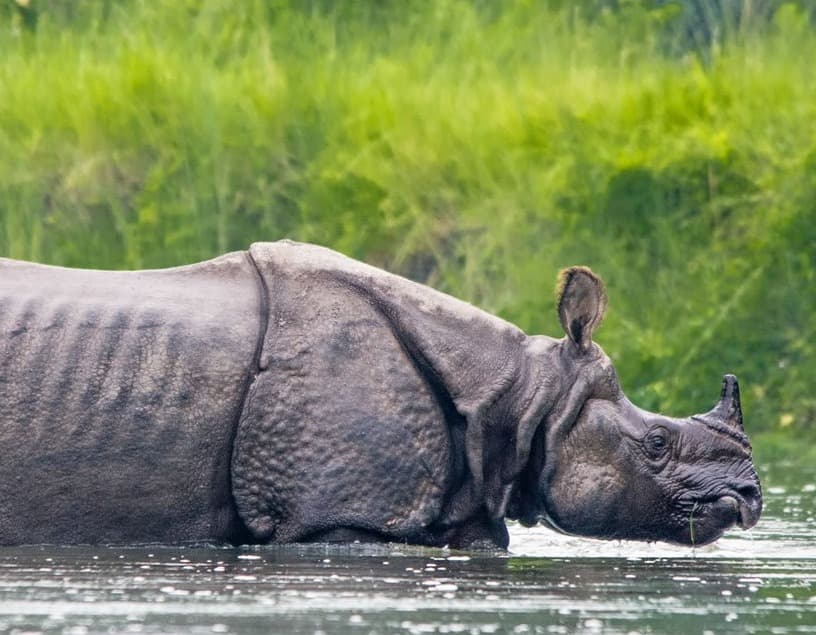
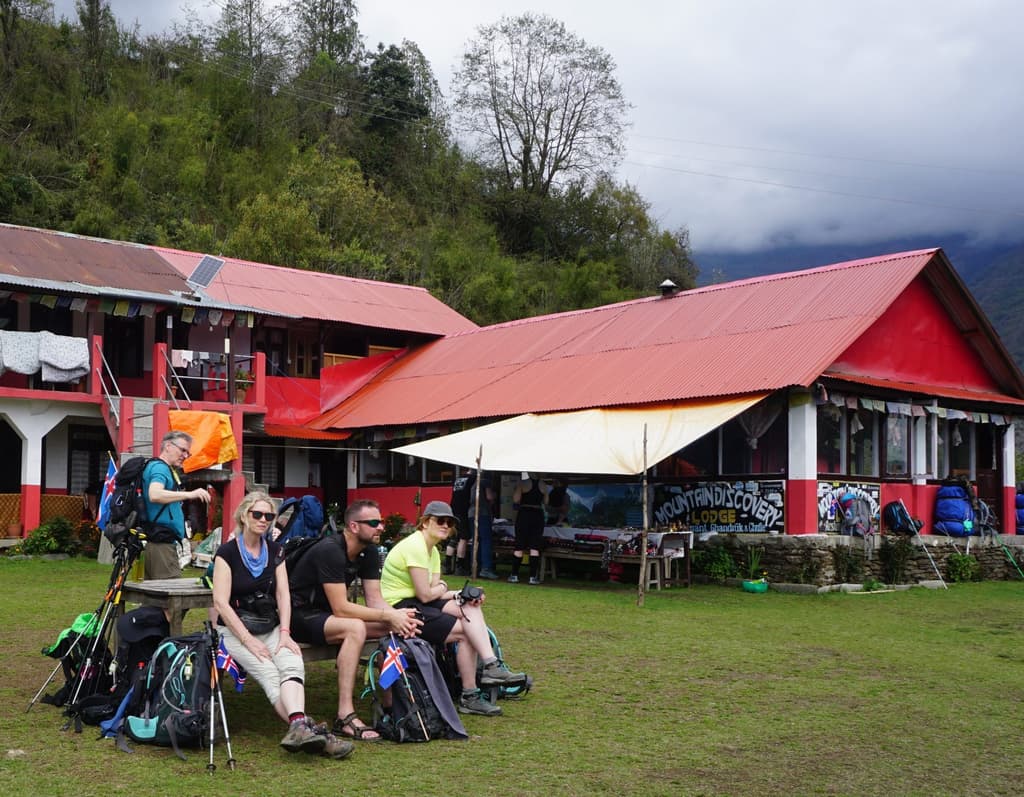
Post a Comment